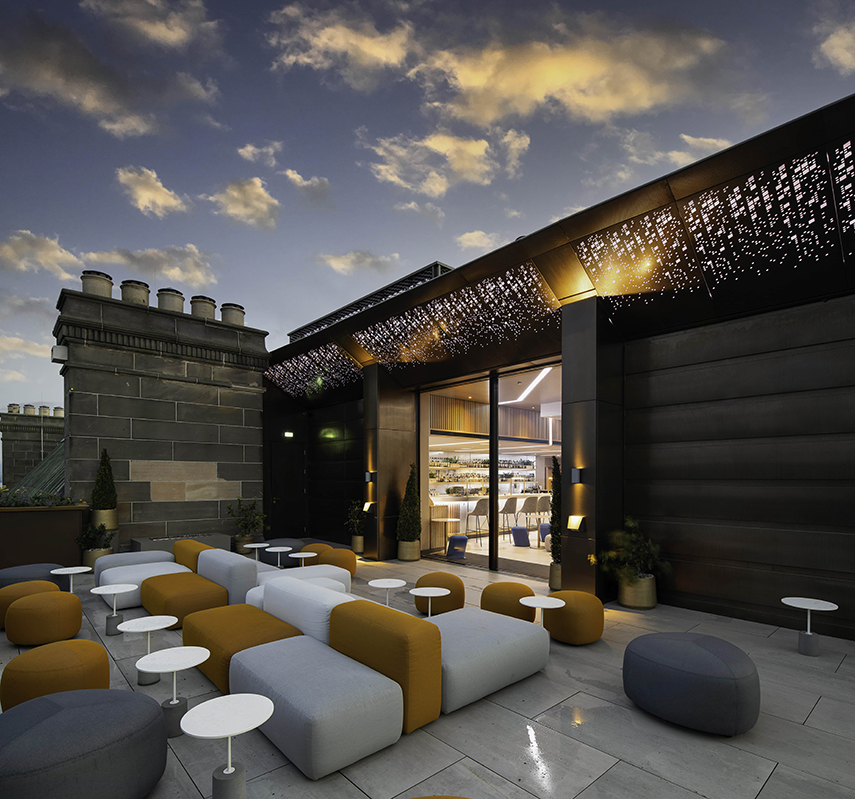
HARLEY Haddow’s senior sustainability engineer has praised industry for the way it has instilled change and stepped up to play its part in the net zero agenda. However, she says there are still strides to be made for those within the public and private sector who have not yet embraced this change.
Lindsay Adams told Project Scotland that she is seeing a greater uptake in moving away from fossil fuels – both in terms of new buildings and existing ones.
Lindsay manages the energy engineering and building modelling team at Harley Haddow, responsible for carrying out feasibility studies and implementing actions with the aim of reducing energy and utilising low carbon strategies.
Harley Haddow has been at the forefront of the sector’s environmental progress, with the business being shortlisted for several industry awards last year and has been recognised as ACE Net Zero Advisor of the Year since 2021.
“(The construction industry) has that stigma of being a bit of a dinosaur, but companies are much more progressive now, especially in the last year or two,” Lindsay explained. “People are definitely looking to invest in the new technologies that are now coming to the market.
“I liaise with clients about what would be possible for existing buildings or for new buildings, looking at technologies we could employ.”

A growing area of work is retrofitting buildings. Lindsay explained that digital twin modelling is often utilised to show clients how much energy and carbon they can save. This involves setting up a virtual identical model of a physical structure to analyse data to see how factors such as moving to a heat pump would affect energy usage and running costs.
When it comes to existing buildings, Lindsay explained there are many technical challenges around upgrading fabric. In some older building stock, interstitial condensation, for example, can be an issue.
“There really needs to be a clear strategy on how possible it is technically to upgrade some of these buildings,” Lindsay added. “Sometimes it’s not quite possible, there might be areas where you can’t physically do it, therefore that poses other challenges.”
Lindsay described the process as sometimes requiring more ‘technical detective work’ to ascertain what the best solution is in each case.
Harley Haddow also works on new buildings, integrating renewable technology into the heart of the design. Lindsay admitted that energy sustainability used to be a ‘bit of an afterthought’ but is now much more embedded to the point where the environment and net zero are often core drivers for a lot of design decisions.

She stressed the importance of early engagement with architects and the wider design team. “The look and feel of the building has to really be influenced by how we’re going to integrate sustainability. For example, what are we doing with the glazing, the orientation of the building, the form of the building? All of these things play a key role in sustainability and the ability to reduce energy demand. Without that key early engagement, some decisions could be made that fundamentally hinder your progress.”
Lindsay has worked on a wide variety of projects across sectors including education, commercial, healthcare, retail, and laboratories. She cited a major project for a university building, where the brief required not only the use of onsite renewables but also wider circular economy gains.
“This involved looking at what happens to the building when you de-construct it, where the materials go, the ecology of the site, making sure we were best capturing rainwater, that we’re not negatively impacting the immediate ecology of the area for the existing infrastructure such as drainage,” Lindsay explained.
“On the retrofit side, we’re working with a Scottish council to look at their existing assets. They’ve got 22 assets in total that they want to transition to net zero. This project involves creating a digital twin model for each of those assets to see what benefit they would get.
“Another non-domestic building that we’ve been working with over a number of years is looking to transition to a heat pump solution, where possible, and also adding a little bit of social equity by expanding their system to supply local social housing.”
With skills shortages well documented across many industries at present, Lindsay revealed there isn’t as much engineering talent in this field as she’d like. In particular, there is a shortage of more senior personnel due to sustainability engineering being a relatively new area of expertise.
The good news, however, is that Scottish universities are developing the future workforce, with Lindsay describing the situation at grassroots level as being ‘quite vibrant’.
“I think all companies would agree that everybody wants more engineers who are technically able to do this type of work because there is an increasing demand for it,” she said. “There are much more emerging university courses trying to pick up on that skills shortage and I do think now we’re seeing a lot more people graduating.
“Particularly in Scotland we’ve got a couple of really great universities producing great engineers.”
One factor which would help to address skills gaps is a more diverse workforce. Lindsay is keen to inspire the next generation of female engineers, highlighting the career opportunities available, the ability to diversify and specialise in different areas, and the fact that many global heads of sustainability are women, including Harley Haddow’s energy and sustainability director, Sarah Peterson, who recently became chair of ACE Scotland.
“I personally have never felt like I’ve been inhibited,” Lindsay added. “Before I was in sustainability, I was a mechanical engineer. That was a lot less diverse than the sustainability side. On sustainability, there’s a much higher representation of females, which is great to see. On my team it’s 50/50.
“Whilst I have never personally had any issues, I do think others have experienced some discrimination. I’d say barriers for women in engineering typically come when it’s site-based work. I think it’s the perception of females on a building site and women shying away because they believe there would be problems; the stereotypical things like construction workers wolf-whistling at women walking down the street. That stigma still plays a big role. It’s not been an appealing industry for women, but I do think it is getting better.”








